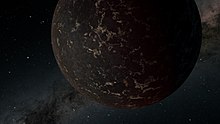astro.wikisort.org - Meteorite
LHS 3844 b is an exoplanet orbiting the red dwarf LHS 3844, about 15 parsecs (49 ly) away in the constellation Indus,[5] discovered using the Transiting Exoplanet Survey Satellite. It orbits its parent star once every 11 hours, and its radius is 1.32 times that of Earth.[1] It has a low albedo, indicating that its surface may resemble that of the Moon or Mercury. LHS 3844 b probably does not have an atmosphere as almost no heat goes to its night side, and it has a dayside temperature of 1,040 K (770 °C; 1,410 °F).[4][6] The presence of cloudy atmosphere with cloud tops above pressure level of 0.1 bar cannot be excluded though.[7]
 Artist’s illustration of LHS 3844 b | |
| Discovery[1] | |
|---|---|
| Discovered by | Vanderspek et al. |
| Discovery date | September 2018 |
Detection method | Transit |
| Designations | |
Alternative names | TOI-136.01, TIC 410153553 b[2][3] |
| Orbital characteristics | |
Semi-major axis | 0.00622±0.00017 AU[2][3] |
Orbital period (sidereal) | 0.46292913±0.00000190 d[2][3] |
| Inclination | 88.50±0.51[3] |
| Star | LHS 3844 |
| Physical characteristics | |
Mean radius | 1.303±0.022 REarth[2][3] |
| Albedo | <0.2[4] |
| Temperature | 1,040 K (770 °C; 1,410 °F) (day side)[4] |
In order to explain the lack of atmosphere, it has been proposed that the planet was formed interior to the star system's snow-line, because if it formed beyond the snow-line it would have carried volatiles, on the surface and in a thick atmosphere, that according to models on atmospheric loss should have been enough to sustain an atmosphere to the present.[8] The planet probably also formed with a volatile-poor outgassing mantle, in a stagnant lid regime, because if the mantle was similar in constitution to Earth's, with plate tectonics, then it should still have a thick atmosphere, unless the red dwarf consistently flared at an uncharacteristically extreme rate not yet considered in atmospheric loss models.[8] An alternative explanation for the lack of atmosphere could be through a large impact event, one with enough momentum to strip the planet of its atmosphere and a large portion of its mantle.[8] In order to explain the non replenishment of volatiles via comets back onto the planet, it is also proposed that perhaps there is an outer gas giant in the star system.[8]
In August 2022, this planet and its host star were included among 20 systems to be named by the third NameExoWorlds project.[9]
See also
References
- Team, the TESS; Villaseñor, Jesus Noel S.; Twicken, Joseph D.; Rose, Mark; Morgan, Edward H.; Pepper, Joshua; Glidden, Ana W.; Fausnaugh, Michael; Davies, Misty D. (2018-09-19). "TESS Discovery of an ultra-short-period planet around the nearby M dwarf LHS 3844". The Astrophysical Journal. 871 (2): L24. arXiv:1809.07242. doi:10.3847/2041-8213/aafb7a.
- "The Extrasolar Planet Encyclopaedia — LHS 3844 b". exoplanet.eu. Retrieved 2019-08-25.
- "LHS 3844 b". NASA Exoplanet Archive. Retrieved 23 July 2020.
- Kreidburg, Laura; et al. (August 2019). "Absence of a thick atmosphere on the terrestrial exoplanet LHS 3844b". Nature. 573 (7772): 87–90. arXiv:1908.06834. Bibcode:2019Natur.573...87K. doi:10.1038/s41586-019-1497-4. PMID 31427764.
- RA 22 41 58, declination -69 10 08, according to SIMBAD Astronomical Databse, LHS 3844.
- Greicius, Tony (2019-08-19). "NASA Gets a Rare Look at a Rocky Exoplanet's Surface". NASA. Retrieved 2019-08-25.
- Diamond-Lowe, Hannah; Charbonneau, David; Malik, Matej; Kempton, Eliza M.-R.; Beletsky, Yuri (2020), "Optical Transmission Spectroscopy of the Terrestrial Exoplanet LHS 3844b from 13 Ground-based Transit Observations", The Astronomical Journal, 160 (4): 188, arXiv:2008.05444, Bibcode:2020AJ....160..188D, doi:10.3847/1538-3881/abaf4f
- Kane, Stephen R.; Roettenbacher, Rachael M.; Unterborn, Cayman T.; Foley, Bradford J.; Hill, Michelle L. (2020-07-28). "A Volatile-poor Formation of LHS 3844b Based on Its Lack of Significant Atmosphere". The Planetary Science Journal. 1 (2): 36. arXiv:2007.14493. Bibcode:2020PSJ.....1...36K. doi:10.3847/PSJ/abaab5.Accepted for publication in the Planetary Science Journal
- "List of ExoWorlds 2022". nameexoworlds.iau.org. IAU. 8 August 2022. Retrieved 27 August 2022.
Другой контент может иметь иную лицензию. Перед использованием материалов сайта WikiSort.org внимательно изучите правила лицензирования конкретных элементов наполнения сайта.
WikiSort.org - проект по пересортировке и дополнению контента Википедии